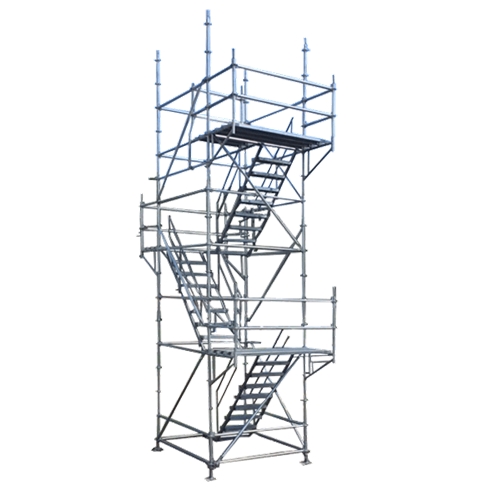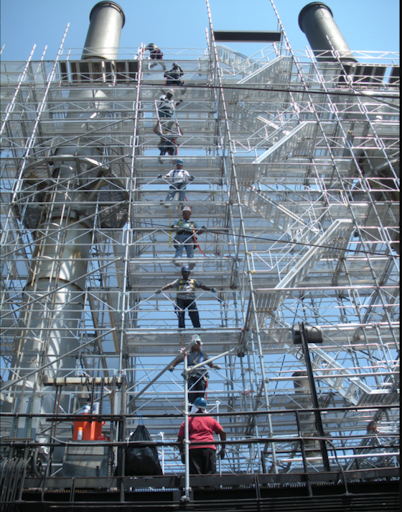Local Scaffolding Company Providing Reliable Services Throughout Surrey
Local Scaffolding Company Providing Reliable Services Throughout Surrey
Blog Article
Exploring the Different Types of Scaffolding Made Use Of in Building Tasks
The building sector counts heavily on numerous types of scaffolding to fulfill specific project requirements, each offering distinct advantages and applications. Conventional frame scaffolding gives a durable foundation for general tasks, while suspended scaffolding is essential for job on skyscraper structures.

Conventional Structure Scaffolding
Typical frame scaffolding is among the most widely utilized methods in the building sector as a result of its effectiveness and convenience. This system consists of vertical and horizontal frameworks that are constructed to create a stable platform for materials and employees. The major parts consist of upright messages, straight journals, and angled dental braces, which together give a strong framework that can support significant lots.
One of the key benefits of standard framework scaffolding is its versatility to numerous building jobs, varying from household structures to big business structures. The modular design allows for very easy assembly and disassembly, making it effective for both long-term and temporary tasks. Additionally, the system can be customized in height and size, accommodating various structure styles and site conditions.
Safety and security is extremely important in scaffolding applications, and conventional structure systems are geared up with guardrails and toe boards to stop drops and ensure employee defense. In addition, routine examinations and adherence to safety and security policies are critical in preserving the integrity of the scaffold. On the whole, standard frame scaffolding remains a basic choice in the building sector, providing a dependable platform for labor and boosting total project performance

Suspended Scaffolding
Put on hold scaffolding offers an one-of-a-kind service for construction tasks that require accessibility to raised surface areas, especially in scenarios where conventional frame scaffolding may be not practical. This kind of scaffolding is generally put on hold from the roof covering or top degrees of a framework, utilizing a system of ropes, systems, and pulley-blocks to produce a working room that can be gotten used to different elevations.
Among the main benefits of suspended scaffolding is its adaptability. It can be quickly rearranged or reduced to suit modifications in building and construction needs, making it excellent for jobs such as home window installation, frontage job, and maintenance on high-rise structures. In addition, the marginal footprint of suspended scaffolding enables better usage of ground area in metropolitan settings, where room is usually limited.
Safety and security is a critical factor to consider in the usage of put on hold scaffolding. On the whole, suspended scaffolding provides a efficient and reliable solution for accessing hard-to-reach areas in numerous building scenarios, boosting both efficiency and safety on site.
System Scaffolding
System scaffolding, usually considered a modern-day remedy in the scaffolding sector, contains pre-engineered elements that can be rapidly put together and adapted for different building jobs. Scaffolding. This kind of scaffolding is characterized by its modular style, which permits flexibility and efficiency on work websites, fitting various heights and architectural needs
Typically made from high-strength steel or aluminum, system scaffolding supplies enhanced longevity and security. The components include vertical articles, straight journals, and diagonal braces, which interconnect firmly, making sure a read this post here robust structure. The style often incorporates standardized fittings, streamlining assembly and disassembly procedures, therefore reducing labor time and expenses.

Rolling Scaffolding
Moving scaffolding is a functional alternative to typical fixed scaffolding, designed for mobility and simplicity of usage on construction sites. This sort of scaffolding contains a system supported by frameworks with wheels, allowing workers to conveniently move it as needed. The mobility attribute considerably enhances performance, as it lessens downtime related to dismantling and putting together taken care of scaffolding.
Commonly built from lightweight materials such as light weight aluminum or steel, rolling scaffolding uses a durable yet portable service for projects calling for frequent repositioning - Scaffolding. It is particularly beneficial in jobs such as paint, drywall setup, and electrical work, where accessibility to different heights and areas is essential
Safety and security is vital in rolling scaffolding pop over to these guys style, with features such as locking wheels to avoid unintended motion when in use, and guardrails to shield workers from drops. Additionally, several versions are adjustable in elevation, suiting different task requirements.
Cantilever Scaffolding

The design of cantilever scaffolding commonly involves using brackets or arms anchored to a building or framework, making it possible for the platform to expand external securely. Security is vital; hence, these find here scaffolds have to be engineered to stand up to numerous lots and ecological conditions. Normal assessment and maintenance are essential to make sure architectural stability and employee security.
Cantilever scaffolding is preferred for its convenience and reliable use area, making it a preferred selection in metropolitan settings where space restraints are usual. Additionally, it promotes easier access to high elevations, ultimately adding to the total performance of construction tasks. As with all scaffolding types, proper training and adherence to security requirements are crucial for employees making use of cantilever scaffolding.
Verdict
Standard framework scaffolding gives security, while put on hold scaffolding provides adaptability for elevated tasks. System scaffolding facilitates fast assembly, and rolling scaffolding improves flexibility for varying work atmospheres.
Traditional frame scaffolding supplies a durable structure for general jobs, while suspended scaffolding is vital for job on skyscraper structures.Rolling scaffolding is a versatile choice to conventional fixed scaffolding, made for wheelchair and ease of usage on building sites. As with all scaffolding types, appropriate training and adherence to safety criteria are vital for workers using cantilever scaffolding.
Traditional structure scaffolding provides stability, while suspended scaffolding offers adaptability for elevated tasks. System scaffolding assists in fast setting up, and rolling scaffolding enhances flexibility for varying job atmospheres.
Report this page